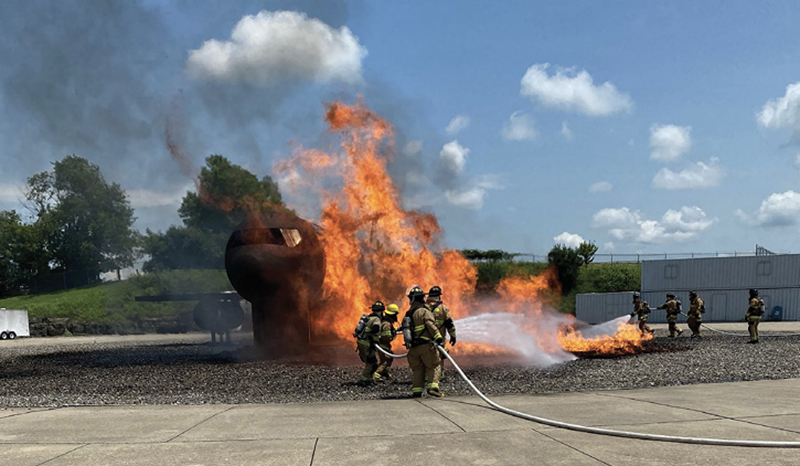Thermal imagers (TI) are powerful tools for structural fires, but what about using TIs to help fight fires dealing with aviation emergencies?
Just the very nature of the fires and the construction of an aircraft result in the TI encountering different challenges not commonly found when fighting a structure fire. With the proper training, however, a TI can be an effective tool when fighting fires in these challenging environments.
An aircraft is a vehicle or machine that takes flight by gaining support from the air. It counters the force of gravity by using either static lift or the dynamic lift of an airfoil or, in a few cases, the downward thrust from jet engines. Common examples of aircraft include airplanes for civil and commercial aviation; single-engine private, multi-jet engine passenger, cargo, military aviation for combat, and noncombat planes; helicopters or rotary wing; private and medivac; and passenger. Each of these aircraft has electrical, engine, fuel, hydraulic systems, plus some sort of either fixed or retractable landing gear.
1 ARFF crews use handlines during a hot drill training exercise. (Photo courtesy of Bullard.)
Fortunately, aircraft fires are not extremely common; however, airport rescue and firefighting (ARFF) departments must always be prepared for an aircraft fire. With the proper response technique, equipment training, and particularly TI training, these firefighting crews can be prepared for any incident. TIs are used to assist in the size-up of an aircraft incident, fire attack, search and rescue, and investigations just like in a structural fire. There is, however, a technical aptitude firefighters need when using a TI in an aircraft incident.
Challenges with Aircraft Fires
The bulk of an aircraft is constructed of aluminum or Duralumin because of its strength and lightweight characteristics, which has a relatively low emissivity. If you recall a previous column, “The Outdoor Effects Emissivity Has on Thermal Imaging” (November 2021), low emissivity doesn’t send its true temperature to the TI. Metal can appear black or gray when you look at it with a TI, even though it may be extremely hot. Reading a TI display with unpainted aluminum could show a deceiving image to the firefighter. Since aluminum is highly reflective of radiation, firefighters need to be aware of how a scene may be altered by reflections of fire, doors, or victims.
Many specialized ARFF vehicles today have built in forward-looking infrared imagers mounted outside of the cab and internal viewing screens. This allows ARFF firefighters to identify a safe passage through the dense smoke of a burning aircraft, to avoid large volumes of fire or dangerous debris from the crash. The TI will also help the firefighters to identify the exact location of doors and windows to help them decide the appropriate entry points. If there are openings in the fuselage from a crash, firefighters can evaluate them as potential entry points as well.
Once inside the aircraft, ARFF firefighters will encounter challenges without access to a hand-held TI. Think of the tight narrow aisles of an aircraft, row after row of seats, and low ceilings made for storing carry-on luggage. Simply put, an aircraft has many obstacles, seats, doors, carts, storage bins, and more not normally seen in a structure fire. Maneuvering past these obstacles can make a quick search difficult because a TI cannot see through solid objects. Firefighters engaged in aircraft fuselage searches much recognize the limitations of a TI and perform an appropriate search that includes thoroughly scanning all realistic areas.
Types of Aircraft Fires
One of the most challenging aircraft fires an ARFF firefighter may face is one involving hydrocarbon fuels. These fires can quickly get out of hand and generate tremendous amounts of heat and black smoke from the foams, plastics, and jet fuel. As a fire takes hold, it’s important to wipe your TI lens clean using a gloved finger, for example, if moisture and soot begin to build up on the lens. More common aircraft fires are not in the fuselage but are external. These include engine fires, hot brakes, or fusible plugs on overheated tires.
Note that not all aviation emergencies happen at airports. Unfortunately, sometimes aircraft can end up not making it to their airport destinations. The responsibility of responding to these emergencies falls on the local fire department, so broad training in multiple scenarios using a TI is always a good idea.
Training as a firefighter is continuous, and the understanding of thermal image interpretation is important. While most firefighters will never fight a fire on an aircraft or at a crash site, there is always that one time when your department might be called on to help.
Manfred Kihn is a 19-year veteran of the fire service, having served as an ambulance officer, emergency services specialist, firefighter, captain, and fire chief. He has been a member of Bullard’s Emergency Responder team since 2005 and is the company’s fire training specialist for thermal imaging technology. He is certified through the Law Enforcement Thermographers’ Association (LETA) as a thermal imaging instructor and is a recipient of the Ontario Medal for Firefighters Bravery. If you have questions about thermal imaging, you can e-mail him at [email protected].


